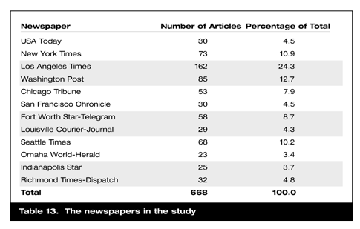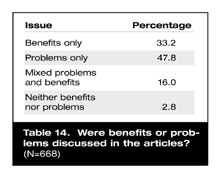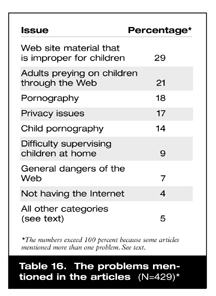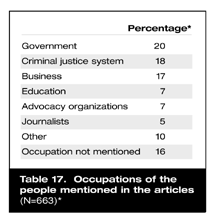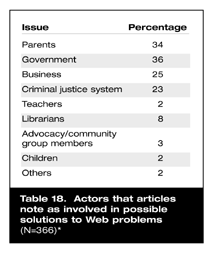 |
|
|
The Internet and the Family: The View from the Press By Joseph Turow <jturow@asc.upenn.edu>, John Bracken, and Lilach Nir Excerpted from The Internet and the Family: The View from Parents, the View from the Press, (c) 1999, Annenberg Public Policy Center, 3620 Walnut St., Philadelphia, PA 19104. All rights reserved. Reprinted by permission. Overview "Your children need the Internet. But, if they do go online, be
terrified."
The press's portrayal of the Internet is particularly significant
because it directly reflects the results of the national survey
presented in part 1 of the report. The great majority of American
parents with computers in the home is conflicted about the Web.
Parents feel it's necessary, but they fear it. Are there alternatives?
The Internet is here to stay. So is the family. At this formative
stage in the family's relationship with the Internet, it is critical
for journalists to help parents and children evaluate the new
world in ways that help parents and children best make sense of
their lives and their society. The Study and the MethodOur investigation was a content analysis of articles in 12 daily
U.S. newspapers from October 15, 1997, through October 15, 1998.
Listed in table 13, six of the papers are among the nation's 10
largest in circulation, and the other six rank from 40th to 50th
in circulation. In locating articles for the analysis, we decided
that for our purpose a "family" was at least one parent with at
least one school-age child. We then conducted a search on the
Lexis/Nexis database for every article in those papers during
the year that (1) mentioned the Internet, AOL, Web, or online
and (2) included the words family, families, child, children,
parent, parents, youth, or teens. The search yielded 668 relevant
We designed a questionnaire to answer two broad questions about
the articles: The Topics in the Articles As table 14 shows, when articles mentioned the Internet and the family, the overwhelming majority-97.2 percent-did so in terms of the problems and/or benefits of the Web. About two-thirds of the pieces described problems, and about half described the Web's benefits. These discussions were quite separate, however. As table 14 shows, only 16 percent of the pieces mixed problems and benefits.
Discussions of benefits in the articles were so subtly varied
that we found they could not be coded reliably into particular
categories. Consequently, we divided the benefits into two broad
categories: those related to social effects of the Web and those
related to the Web's psychological effects. We defined social
effects as those that impact on the activities between people;
using e-mail to keep in touch with relatives is an example. We
defined psychological effects as those that impact on the mental
activities of people; a Web site that to helps a child read or
improves the knowledge of family members are instances of psycholog-ical
effects. Table 15 presents the benefits. The numbers add up to more than 100 percent because coders reliably found up to two benefits in the 331 articles that noted a benefit. The table indicates that the Web's utility was noted much more often in relation to children than in relation to the family as a whole. Psychological utility received more mentions than social utility.
Unlike the broad and scattered discussion of the Internet's benefits, discussion of the Web's problems centered on a small number of rather specific dangers. Table 16 presents the problems. Again, the numbers add up to more than 100 percent because we found that the coders could reliably record up to two problems in the 429 articles that noted one or more of them.
A number of startling points emerge in the table. First, sex and
sex crimes related to the Web and children received much attention,
making up 53 percent of all the problems. Second, a large number
of articles discussed Web sites that are improper for children
because they promote activities that children should not be doing,
like drinking, smoking, and using illegal drugs. Third, articles
were so fixated on outside influences preying on children for
purposes of sex, improper activities, and privacy invasion that
all other issues mentioned regarding the Internet and the family
made up only 5 percent of the total. These other issues included
parents' management of children's Internet time; supervision of
Internet use at home and school; commercialism and the Web; the
Web and parents' careers; hate groups on the Web; income divisions
among Web haves and have-nots; and negative social and psychological
implications of the Web for the family. Discussions of race and
the Web-either problems or benefits-were mentioned only seven
times in our entire sample. The People Quoted in the Articles We asked how many people journalists quoted about problems and
benefits of the Web, who they were, and what they said. Going
through the 668 articles in our sample, we found 663 people whose
comments the articles cited. Of all of the sources quoted, educators,
journalists, and businesspeople were the most positive in portraying
the Web's relationship to the family. About 60 percent of the
time that these individuals appeared in articles, they mentioned
potential benefits of the Internet. But their positive views didn't
appear very much. As table 17 indicates, educators and journalists
together made up less than 13 percent of the people who were quoted.
Solutions to the Problems Articles that noted problems about the Web and the family described attempts to solve them 85 percent of the time. Table 18 presents the kinds of individuals and organizations involved in those attempts and the percentage of articles in which they appeared. It indicates that government, parents, business, and the criminal justice system (police, the criminal courts) figured most prominently in trying to find a way out of the frightening issues posed for parents and children by the Web. The articles mentioned the individuals or organizations by themselves a bit more than half-55 percent-of the time. In a bit less than half-45 percent-of the articles, solutions involved more than one type of actor. Parents and business and parents and government were most common.
Reporters' attention to parents along with business or government
in discussing answers to Web crime, pornography, and privacy invasions
should not be taken to mean that the answers showed parents working
with executives and elected officials. To the contrary, the press
depicted each party in its own domain. The federal government
was making laws to try to stop the scourges. Businesses were developing
Web-filtering software that parents could purchase. Police and
the criminal courts were arresting and incarcerating pedophiles
and child pornographers. A complete copy of the The Internet and the Family: The View from Parents, the View from
the Press by Joseph Turow is available for downloading at the Annenberg Public Policy Center Web site. |


